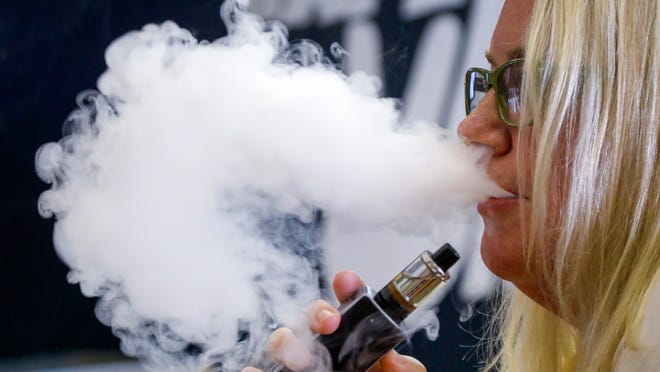SAN FRANCISCO — The recent outbreak of lung injuries linked to vaping has highlighted the dangers of e-cigarettes. A new study puts the warning in big, red letters.
Often promoted as a healthier alternative to smoking, vaping increases the chances of developing chronic pulmonary diseases like emphysema, asthma and bronchitis by 30%, the report said. And people who smoke both conventional and electronic cigarettes – the majority of vapers 18 and older – more than triple their risk of having respiratory illnesses.
The conclusions come from the first study on the long-term health impacts of vaping on a representative adult population, conducted by the University of California-San Francisco and published Monday in the American Journal of Preventive Medicine.
The analysis tracked 32,000 U.S. adults without any previous signs of lung disease from 2013-2016, and it found stronger evidence of the connection between vaping and respiratory ailments than previous studies that looked at a moment in time and couldn’t establish a causal link.
'Something has changed': People have been vaping for years but now they're dying. Could it be the devices?
“We concluded that e-cigarettes are harmful on their own, and the effects are independent of smoking conventional tobacco,’’ said lead author Stanton Glantz, a UCSF professor of medicine and director of the school’s Center for Tobacco Control Research and Education.
“Dual users – the most common use pattern among people who use e-cigarettes – get the combined risk of e-cigarettes and conventional cigarettes, so they're actually worse off than tobacco smokers.’’

The research found the rate of chronic pulmonary illnesses among current vapers is 1.3 times higher than for non-users, compared to 2.6 times higher for smokers and more than three times as high for those who do both.
That would seem to validate the contention that e-cigarettes are safer, and Glantz said in theory they are, but not so much in practice because less than 1 percent of smokers switch completely to vaping.
“For most smokers, they simply add e-cigarettes and become dual users, significantly increasing their risk of developing lung disease above just smoking,’’ said Glantz, who noted the adverse effects emerged in just a few years.
CDC reported 2,409 EVALI cases requiring hospitalization and 52 fatalities as of Dec. 10
The findings represent another blow to the e-cigarette industry, which came under increased scrutiny this year with the sudden spike in what’s now known as EVALI, a newly coined acronym for e-cigarette or vaping-associated lung injury.
At one point, as the number of cases mounted at a rapid pace, President Donald Trump called for a ban on most flavored e-cigarettes, though he seems to have backed off that stance.
Similar approach:Vape manufacturers using Big Tobacco tactics to attract addicts for life
The Centers for Disease Control and Prevention said that, as of Dec. 10, there have been 2,409 EVALI cases resulting in hospitalization and 52 in deaths, with instances in all 50 states as well as Puerto Rico and the U.S. Virgin Islands.
The rate of incidence has been declining in recent weeks, but the CDC continues to warn against the use of e-cigarettes containing THC – the psychoactive ingredient in marijuana – especially those obtained from informal sources, such as street sellers.
The vast majority of the EVALI cases have been linked to products containing THC, though neither a specific brand nor a cause for the outbreak has been identified.
Mangala Narasimhan, a lung specialist and regional director for critical care medicine at Northwell Health in New Hyde Park, New York, said her network has treated about 40 EVALI patients, and two of them almost died.
In tracking the patients’ progress, she has noticed that even those who have returned to normal lives still don’t have their full pulmonary capacity and deal with shortness of breath.
Is marijuana linked to psychosis, schizophrenia? It's contentious, but doctors, feds say yes
Narasimhan’s concerns go beyond the professional. She’s the mother of a middle schooler and a high schooler, and said many of their friends vape.
“It’s 100 percent not safe. It’s definitely not a benign thing to do,’’ Narasimhan said. “I think people have funny perceptions about the safety of these things.’’
The conclusions from this latest study further complicate Narasimhan’s job in helping smokers quit the highly addictive habit. She had been among the doctors who advised patients who struggled to quit to try vaping, which provides the quick nicotine high they wouldn’t get from gum, patches or lozenges.
Now that option has been effectively taken out of her toolkit.
“This has been a heated argument in the pulmonary community because we thought we were helping patients by getting them off the cigarettes and going to this,’’ she said, “but clearly that’s not the case.’’

